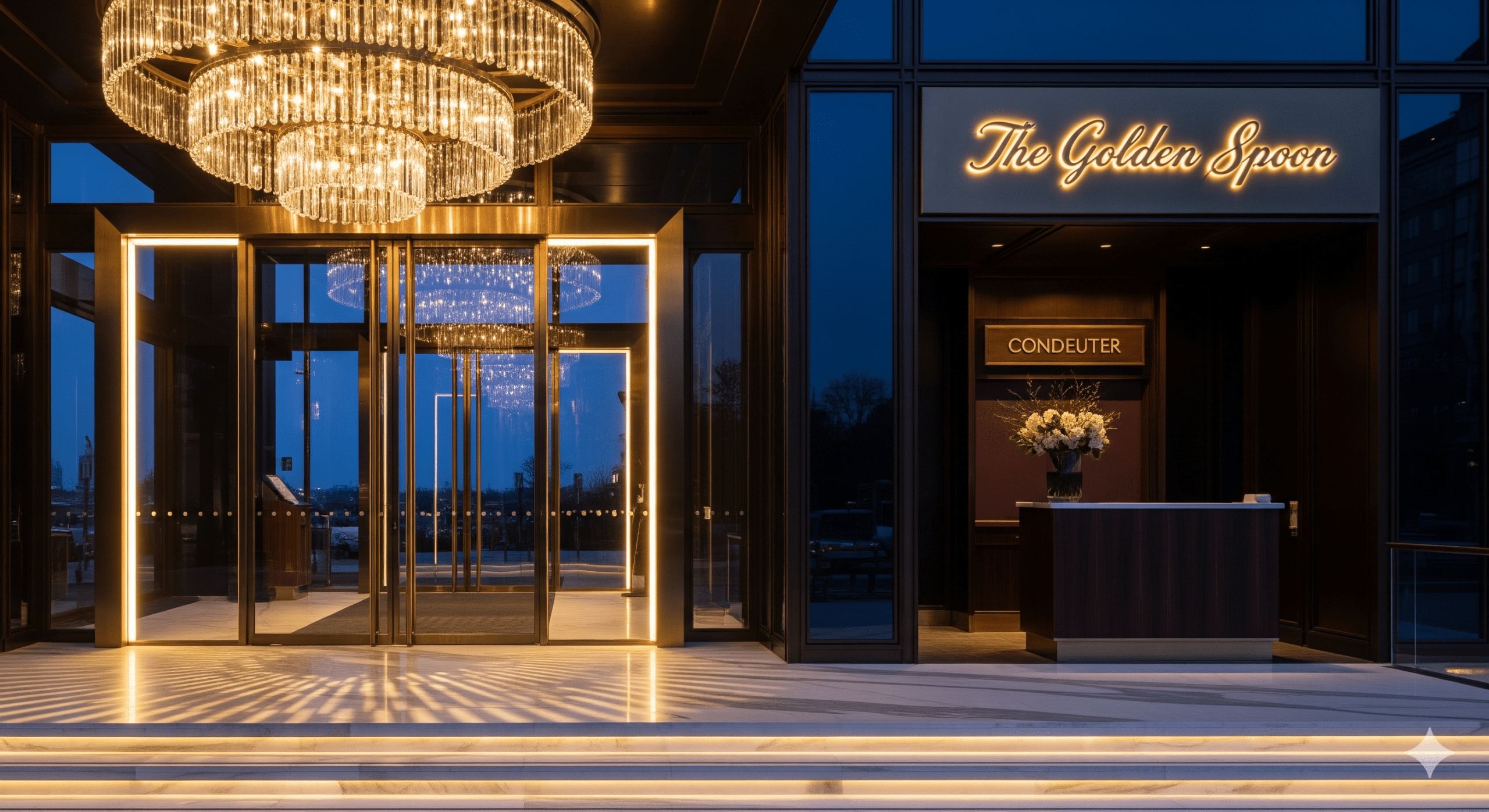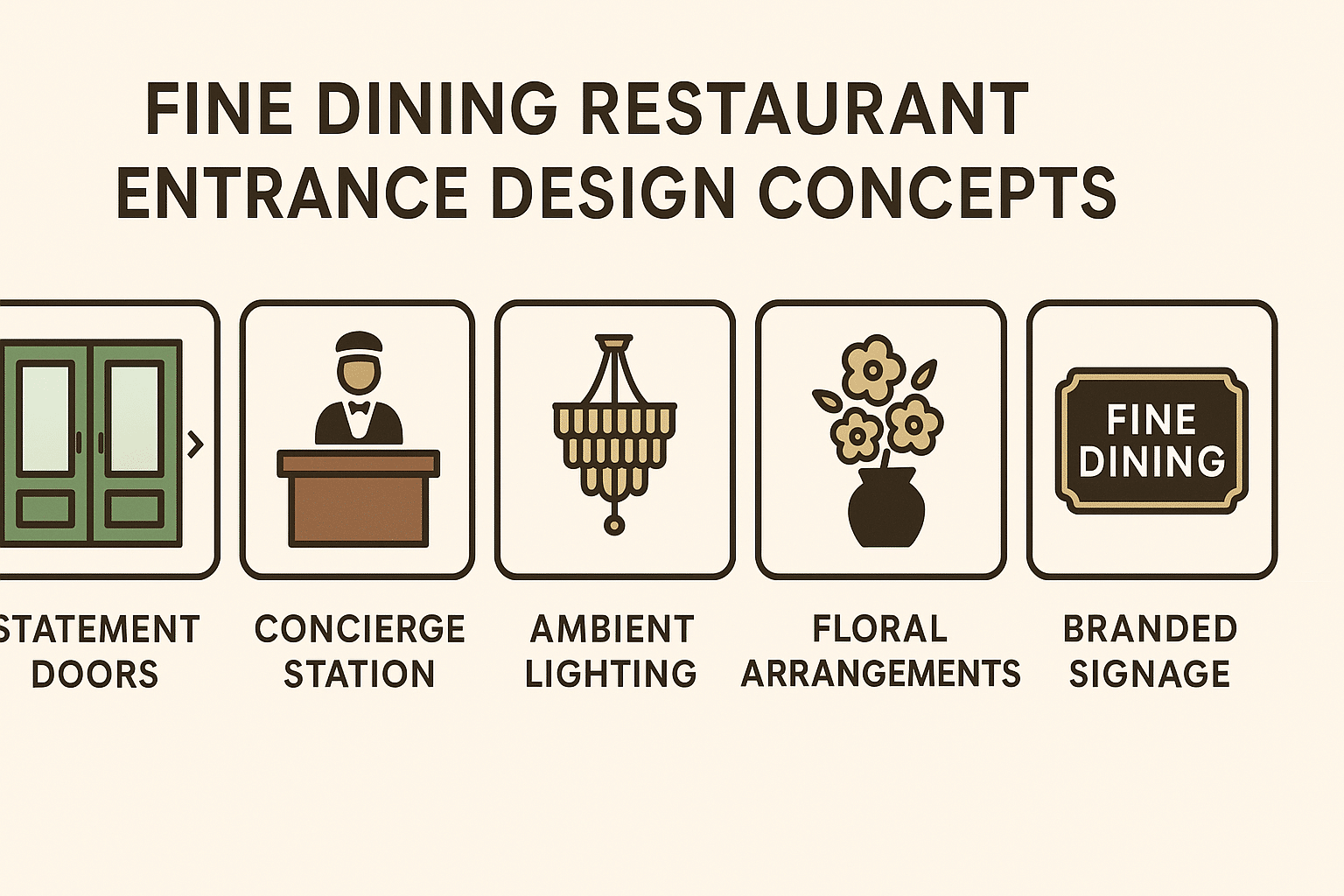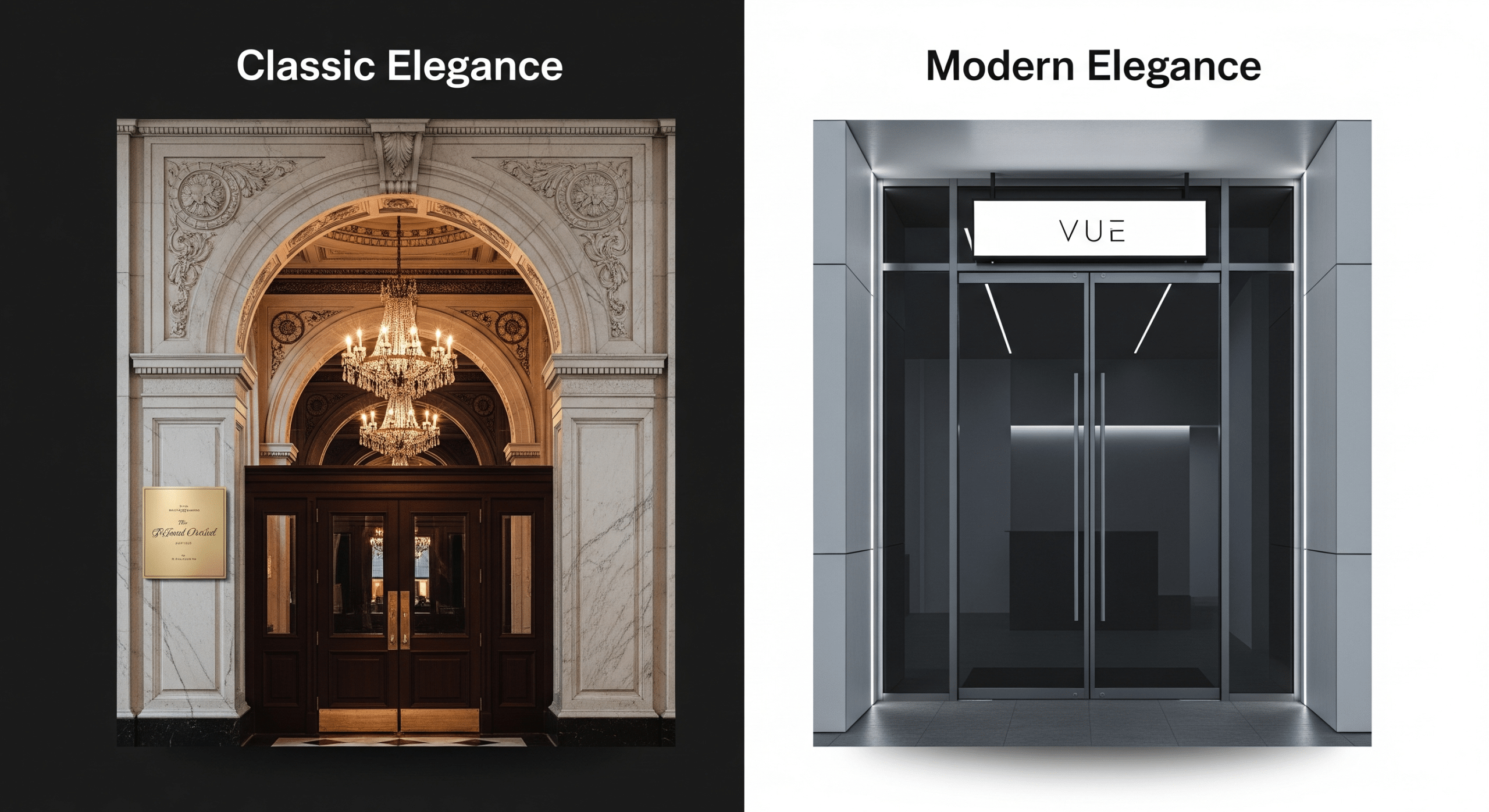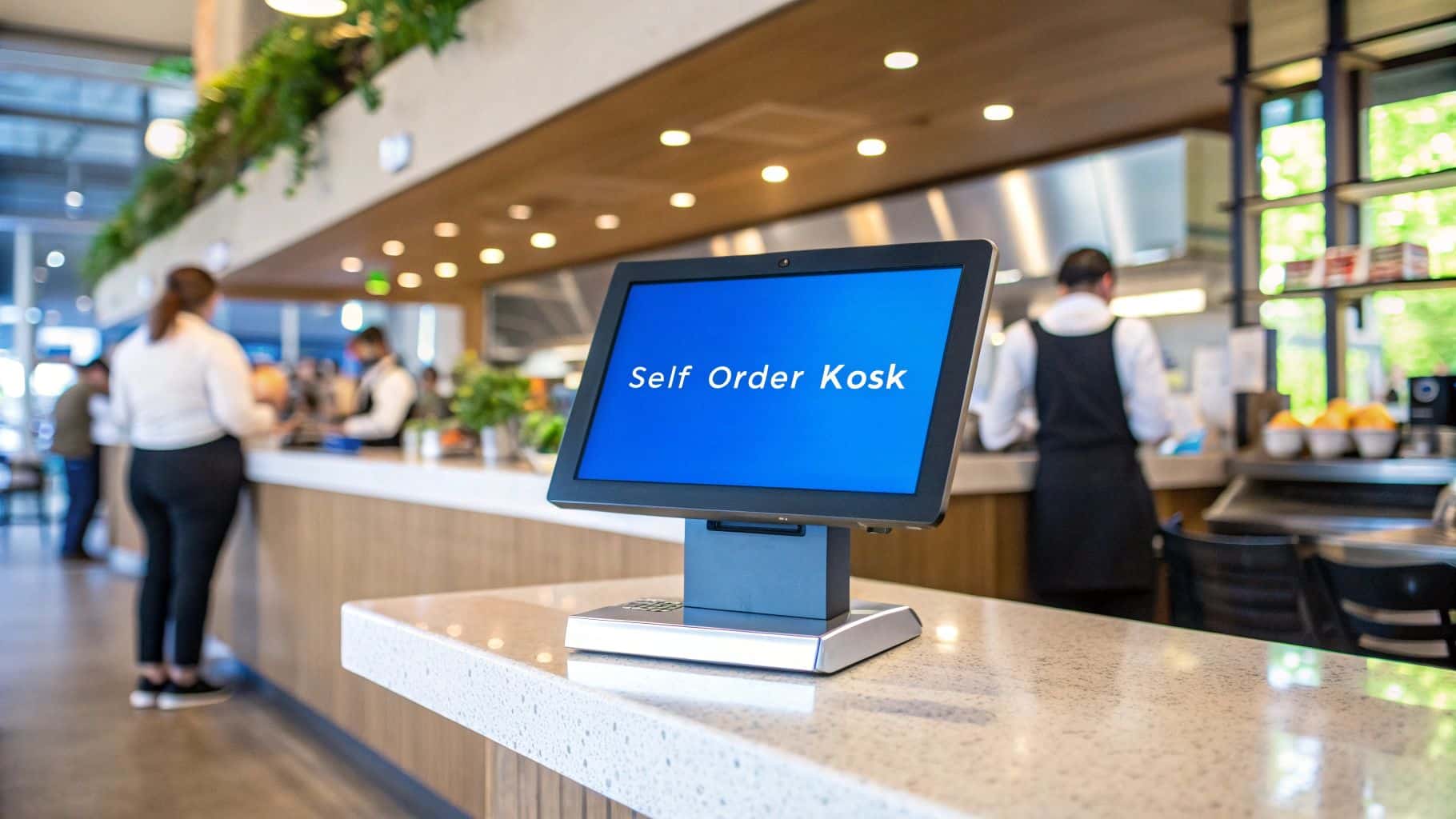When guests step up to a fine dining restaurant, their experience begins before they even taste the first dish. The entrance sets the tone, shaping perceptions of quality, luxury, and ambiance. Fine dining restaurant entrance design concepts go beyond aesthetics; they establish the emotional and sensory stage for a memorable dining experience. From elegant signage to premium architectural details, the entrance creates a lasting impression that influences how guests perceive service, food, and overall value. In this article, we’ll explore essential design strategies, from lighting to landscaping, to help you craft a statement entrance worthy of high-end hospitality.
Table of Contents
- Grand Entrance Concepts for Luxury Appeal
- Chandelier Lighting and Ambient Atmosphere
- Premium Materials and Architectural Elegance
- Floral Arrangements and Sophisticated Décor
- Branded Signage and Exclusive Identity
- FAQ
Grand Entrance Concepts for Luxury Appeal
Fine dining restaurant entrance design concepts thrive on creating a grand and memorable sense of arrival. A carefully curated entrance signals sophistication and reassures guests they are about to enjoy an extraordinary experience. The use of grand doors, red carpets, and concierge stations elevates the arrival moment into a part of the dining ritual itself.
Statement Doors as the Gateway
Large and ornate doors immediately signal exclusivity and status. Fine dining restaurant entrance design concepts often feature oversized wooden doors, sleek glass panes, or metal-framed entrances that match the restaurant’s overall theme. Guests perceive these grand doors as a visual metaphor for entering a world of refined taste and high standards. The scale and material of the doors create a psychological sense of importance, signaling that what lies beyond them is special and deserving of attention.
Architects and designers often integrate premium materials such as brass handles, etched glass, or carved wood to reinforce the sense of luxury. These details enhance the tactile experience for guests, turning a simple act like pulling open a door into a sensory cue of sophistication. Every texture, from the coolness of metal to the polish of hardwood, communicates deliberate craftsmanship. These details ensure that the guest’s first physical interaction with the restaurant conveys refinement and intentionality.
For instance, a restaurant with a contemporary menu may choose minimalist glass doors with subtle lighting, while a classical fine dining setting may prefer carved double doors that showcase tradition and heritage. Each design choice tells a story about the dining experience to come. Guests already feel immersed in the restaurant’s brand values before they sit down, thanks to the entrance design that shapes their mindset toward luxury and exclusivity.
Concierge Stations for Personalized Welcomes
A concierge or host station at the entrance reinforces the idea of exclusivity and service excellence. Fine dining restaurant entrance design concepts often use concierge stations not just as functional desks but as design features that embody refinement. A well-dressed concierge or host greeting guests sets the emotional tone, signaling warmth and attentiveness before the first menu is even handed over.
Stations may feature marble tops, ambient accent lighting, and discreet technology for reservations. This integration of luxury and practicality ensures that operational elements remain hidden behind elegant surfaces. For example, tablets may be concealed within sleek drawers, while ambient lighting highlights the concierge’s presence without creating visual clutter. The blend of aesthetics and function maintains the upscale atmosphere while making guest interactions smooth and seamless.
Concierge stations also serve as the psychological shift from outside to inside, offering a transition space that reassures guests they are valued. A well-designed station communicates order, professionalism, and care. Guests instinctively feel that the restaurant is not only about fine food but also about orchestrated experiences where every detail is planned to enhance comfort and anticipation.
Red Carpets and Luxurious Pathways
Few symbols of luxury are as universally recognized as a red carpet. Many fine dining restaurant entrance design concepts borrow this element from hospitality and entertainment industries to reinforce status and prestige. A carpeted pathway ensures that guests feel special the moment they arrive, as if they are walking into an exclusive event crafted solely for them. This psychological boost instantly heightens expectations and deepens the sense of occasion.
Restaurants may choose classic red velvet runners or opt for custom colors that align with their brand identity. A contemporary fine dining venue might select sleek black with subtle metallic accents, while a French-inspired brasserie might use a traditional crimson. These decisions communicate the restaurant’s aesthetic direction, showing guests that branding extends to every visible detail. Custom monograms or embedded patterns in the carpet can further emphasize exclusivity and recognition.
Beyond visual appeal, luxurious pathways serve practical functions as well. They guide foot traffic efficiently, protect flooring from high use, and provide slip resistance in inclement weather. When paired with architectural details such as columns or planters, the carpet integrates into a broader narrative of refinement. The walk from the street to the front door becomes a curated moment of anticipation, turning even a short journey into part of the dining experience.
Chandelier Lighting and Ambient Atmosphere
Lighting is one of the most powerful tools in fine dining restaurant entrance design concepts. It not only sets the mood but also enhances architectural features and materials. Chandelier lighting, wall sconces, and discreet LED accents contribute to creating a welcoming ambiance that is elegant yet functional.
Chandelier Lighting as a Focal Point
Chandeliers have long symbolized grandeur and sophistication. In many fine dining restaurant entrance design concepts, they serve as a dramatic centerpiece, drawing eyes upward and creating a sense of awe. The sparkle of crystals or the glow of modern sculptural lighting adds theatrical elegance that immediately tells guests they are in an elevated environment designed for unforgettable experiences.
Beyond aesthetics, chandeliers provide layered lighting that spreads warmth across the entrance. Their glow softens the environment, reducing harsh shadows and creating an atmosphere of comfort and exclusivity. This balance between light and shadow enhances textures in flooring, walls, and décor, ensuring that every detail feels intentional and harmonious. Guests entering under such light immediately associate the environment with luxury and refinement.
Designers often place chandeliers strategically above entry foyers, ensuring they dominate the visual field while complementing other décor elements. Whether traditional or avant-garde, these lighting pieces can double as art installations. Their role extends beyond illumination; they embody the restaurant’s personality and set expectations for the dining journey ahead.
Ambient Lighting for Mood Setting
Soft, layered lighting contributes significantly to ambiance. Fine dining restaurant entrance design concepts often include wall sconces, recessed LEDs, or hidden uplights to create depth and sophistication. These lighting techniques work together to guide guests subtly while enveloping them in warmth, ensuring a smooth transition from bustling exteriors to serene interiors.
Ambient lighting can highlight architectural details such as columns, arches, or textured stone walls. By focusing light on these elements, designers add richness to the entrance environment. Guests feel that every feature has been carefully considered, which reinforces the idea of a curated luxury experience. Subtle shadows and highlights elevate visual drama without overwhelming the senses.
The choice of light temperature also shapes perception. Warm tones project intimacy and relaxation, aligning with traditional fine dining atmospheres. Cooler whites may be used for modern elegance, emphasizing minimalism and precision. Regardless of style, the lighting must remain consistent across the entrance to prevent visual or emotional dissonance.
Exterior Lighting and Landscaping Harmony
Exterior lighting transforms the journey before guests even step inside. Fine dining restaurant entrance design concepts often use ground-level pathway lights, spotlights for architectural features, and uplighting for trees or sculptures. These lighting techniques ensure that the restaurant stands out from its surroundings, even from afar, drawing attention and excitement as guests approach.
Landscaping gains new life under proper illumination. Sculpted hedges, floral beds, or fountains can be highlighted to create a theatrical effect. Guests enjoy a visual preview of the attention to detail awaiting them inside. Strategic lighting choices add an element of drama, ensuring that the path to the restaurant feels safe, inviting, and distinctly luxurious.
Consistency remains vital. Exterior lights should harmonize with interior tones to ensure a seamless transition. The aim is not just to guide guests but to extend the luxury brand experience from the street to the first step inside. A well-lit façade combined with carefully illuminated landscaping assures guests that the restaurant values beauty, safety, and exclusivity equally.
Premium Materials and Architectural Elegance
Material choice defines the tactile and visual luxury of fine dining restaurant entrance design concepts. Elements like marble flooring, upscale façades, and architectural details set the tone for refinement and exclusivity. These physical components communicate permanence and high value.
Marble Flooring for Timeless Luxury
Marble has stood as a timeless symbol of elegance for centuries, used in palaces, cathedrals, and luxury estates. In fine dining restaurant entrance design concepts, marble flooring sends an immediate message of refinement and exclusivity. Its polished surface reflects light beautifully, creating a sense of spaciousness and grandeur the moment guests step inside. Walking across marble gives diners a physical cue that they are entering a place of sophistication and status.
The versatility of marble allows restaurants to customize the atmosphere. White Carrara marble conveys purity and classic elegance, while darker options like black Marquina create dramatic impact. Designers may also incorporate patterned inlays or contrasting borders to elevate visual interest. Each decision contributes to brand storytelling—whether evoking timeless tradition or modern luxury.
Practical benefits further support marble’s popularity. Its durability withstands heavy foot traffic without losing polish, making it ideal for high-volume fine dining establishments. Marble requires minimal upkeep compared to softer materials and gains character over time. For restaurateurs, investing in marble flooring ensures a long-lasting design element that consistently reinforces exclusivity and sophistication.
Upscale Façades with Lasting Appeal
The façade of a restaurant is its first introduction to the world. In fine dining restaurant entrance design concepts, upscale façades distinguish establishments from neighboring spaces and create a memorable presence. Guests often form their expectations before entering, and a carefully crafted façade ensures those expectations align with the restaurant’s luxury promise.
Designers often choose premium materials such as stone, glass, wood, or metals for façades. Each material conveys distinct characteristics: stone communicates permanence and tradition, glass offers transparency and modernity, and wood evokes warmth and authenticity. By blending these elements harmoniously, a façade becomes both an aesthetic statement and an architectural signature.
Many restaurants further enhance façades with intricate artistic details such as sculpted panels, engraved logos, or custom lighting features. These elements transform the exterior into a brand landmark, ensuring recognition even from afar. Guests begin forming emotional connections the moment they see the façade, associating its design with exclusivity and high standards of dining.
Architectural Details that Elevate Design
Fine dining restaurant entrance design concepts thrive on small yet powerful architectural details. Molding, trim, and accent pieces may seem minor individually, but collectively they create an environment of completeness and refinement. Guests may not consciously notice each detail, but they feel the elevated ambiance such details provide.
Architectural details also create opportunities for personalization. Custom motifs carved into door frames, handrails with artistic designs, or engraved metallic fixtures all tell stories about the restaurant’s identity. These subtle features remind guests that they are entering a space where no detail has been overlooked, reinforcing exclusivity and attention to craftsmanship.
When aligned with premium materials, these details complete the overall experience of elegance. They serve as silent markers of quality, assuring guests that the restaurant cares not only about the culinary journey but also about every aspect of design. The result is a cohesive entrance that embodies sophistication at every level.
Floral Arrangements and Sophisticated Décor
Décor plays a crucial role in softening architectural elements and adding warmth. Fine dining restaurant entrance design concepts often use floral arrangements, artistic accents, and seasonal touches to enhance ambiance. These create a welcoming environment that resonates emotionally with guests.
Floral Arrangements as Living Art
Flowers elevate spaces by adding vibrancy, scent, and freshness. In fine dining restaurant entrance design concepts, floral arrangements function as living art installations that signal care, beauty, and exclusivity. The presence of carefully arranged blooms tells guests that the restaurant values both aesthetics and sensory experiences beyond cuisine.
Floral selection conveys brand personality. Orchids may symbolize modern minimalism, roses evoke romance and tradition, while exotic tropical flowers communicate boldness and creativity. By curating arrangements seasonally, restaurants show attentiveness and adaptability, reminding guests that design evolves just as menus do. Each arrangement can also be color-coordinated with brand palettes for cohesion.
Placement is equally strategic. Tall vases at doorways create dramatic entrances, while smaller arrangements at concierge stations add subtle elegance. Their fragrance enhances the guest journey subconsciously, connecting memory and emotion to the dining experience. Flowers become more than decoration; they serve as an emotional welcome.
Artistic Accents for Unique Identity
Art communicates culture and personality, making it an essential part of fine dining restaurant entrance design concepts. Sculptures, murals, or digital installations offer visual intrigue that differentiates one restaurant from another. Guests instantly perceive such details as signs of refinement and creativity, connecting the dining space with artistry and inspiration.
For example, Mediterranean restaurants may incorporate mosaic walls that reference historical craftsmanship, while modern dining establishments might choose abstract steel sculptures that suggest innovation. These accents not only beautify entrances but also create unique identifiers that guests recall and share, both verbally and on social media. This word-of-mouth impact extends branding beyond the walls of the restaurant.
When art integrates with lighting and architecture, the effect is theatrical yet tasteful. Guests feel that they are entering not just a dining room, but a curated cultural experience. Such artistic statements position the restaurant as a destination rather than a mere eatery, enhancing exclusivity and memorability.
Seasonal Décor for Dynamic Appeal
Seasonal décor ensures entrances never feel static or stale. Fine dining restaurant entrance design concepts embrace evolving design elements that reflect cultural events, holidays, or changes in nature. This dynamic approach keeps guests engaged and intrigued throughout the year, encouraging return visits to witness new visual experiences.
Winter may bring twinkling lights, evergreen wreaths, or velvet accents, while spring could showcase cherry blossoms and pastel tones. Autumn might emphasize harvest themes with rich colors and pumpkins, while summer entrances highlight bright florals and airy arrangements. These design shifts demonstrate cultural awareness and attention to detail, both valued in fine dining.
By changing décor seasonally, restaurants also create anticipation. Regular patrons look forward to new designs and experiences with each visit. This practice not only strengthens customer loyalty but also reinforces the idea that the restaurant is alive, responsive, and consistently invested in delivering memorable luxury moments.
Branded Signage and Exclusive Identity
Branding is essential in hospitality, and entrances are prime opportunities for communication. Fine dining restaurant entrance design concepts often incorporate elegant signage, branded materials, and cohesive design choices to ensure recognition and loyalty.
Elegant Signage for First Impressions
Signage acts as the restaurant’s handshake with the public. In fine dining restaurant entrance design concepts, elegant signage must convey sophistication while ensuring clarity and visibility. Every design choice—from typography to illumination—sends a message about the brand’s identity and promise of exclusivity.
Many luxury restaurants favor backlit lettering, engraved metal plaques, or subtle etching on glass. These approaches balance functionality with refinement, ensuring guests can find the restaurant while still perceiving a sense of mystery and allure. The signage avoids gaudy presentations, instead projecting confidence in the brand’s prestige.
When executed well, signage integrates seamlessly with façades, doors, and décor. Guests perceive it not as an isolated element but as part of a larger cohesive design. This subtle integration ensures that the entrance communicates sophistication without overwhelming the senses.
Branded Design for Cohesive Identity
Consistency across all design elements reinforces recognition and trust. Fine dining restaurant entrance design concepts often integrate brand motifs, colors, and logos into architectural and decorative details. This ensures that every part of the entrance feels intentional and aligned with the brand narrative.
For instance, a restaurant might feature its logo subtly etched into glass doors, embroidered onto carpets, or engraved into metal fixtures. Brand colors may appear in floral arrangements, light hues, or even concierge uniforms. Guests recognize these patterns subconsciously, reinforcing brand loyalty through repetition and coherence.
This cohesive design approach enhances memorability. When all elements—architecture, décor, and branding—speak the same visual language, guests recall the experience with clarity and fondness. They share these impressions with others, strengthening reputation and market positioning.
Statement Entrances for Recognition
Statement entrances serve as iconic visual landmarks that guests immediately associate with the restaurant. Fine dining restaurant entrance design concepts often leverage bold architectural features, custom lighting, or dramatic pathways to create unique entrances that stand out in memory. These elements encourage guests to describe restaurants not only by name but also by their distinctive visual identity.
A statement entrance might include an illuminated archway, sculptural gates, or a signature canopy. These features elevate the restaurant from being merely a dining location to becoming a cultural destination. Guests share photos of such entrances, further enhancing recognition through digital word-of-mouth and social platforms.
The most successful statement entrances balance grandeur with approachability. While they impress, they must still feel welcoming and accessible. A bold entrance that intimidates could alienate guests, whereas one that combines artistic flair with warmth ensures both prestige and comfort. Achieving this balance secures the restaurant’s reputation as exclusive yet inviting.
Elevating Guest Experiences Through Entrances
Fine dining restaurant entrance design concepts are more than decorative choices—they are powerful storytelling tools that shape perception, emotion, and expectation. Every material, flower, and light fixture contributes to an atmosphere of exclusivity and sophistication. When executed with care, entrances transform into lasting memories that guests associate with exceptional dining experiences.
If you’re designing or upgrading your restaurant, don’t overlook this critical detail. Entrances set the stage for everything that follows, from service to cuisine. Investing in these design choices is an investment in long-term reputation and success.
Restaurants can also streamline guest experiences inside by integrating smart technology like Biyo POS. With advanced point-of-sale solutions, seamless order management, and customer engagement tools, Biyo POS empowers fine dining venues to complement stunning entrances with equally impressive service. To explore how Biyo POS can transform your operations, sign up here.
FAQ
What makes a fine dining restaurant entrance stand out?
Memorable entrances combine premium materials, elegant lighting, and personalized service touchpoints. Features like chandeliers, marble floors, and concierge stations help establish exclusivity and sophistication.
How important is lighting in restaurant entrance design?
Lighting plays a crucial role in shaping ambiance. Chandeliers, sconces, and exterior landscape lighting create mood, highlight architecture, and guide guests seamlessly from outdoors to indoors.
Why should branding be included in entrance design?
Branded signage and motifs create consistency across guest touchpoints. A well-designed entrance not only looks impressive but also reinforces brand identity, making the restaurant instantly recognizable and memorable.






